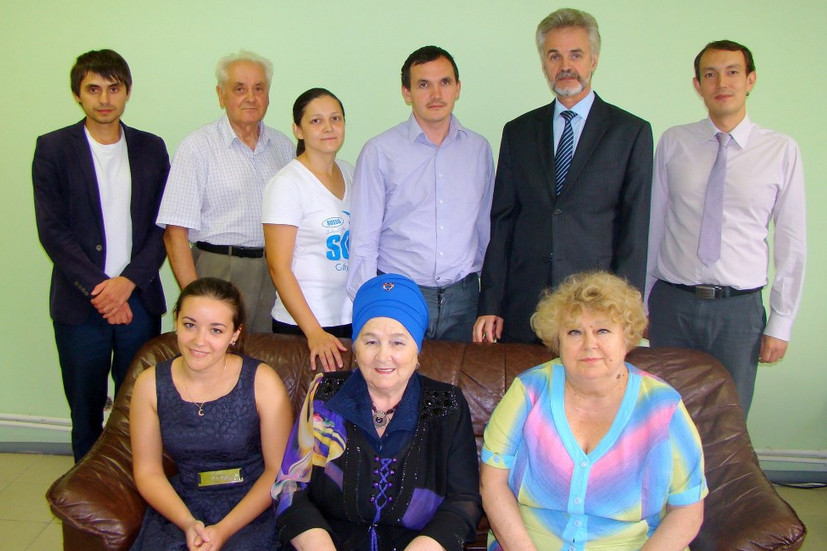DEVELOPMENT OF A MODIFIED ALKALINE CATALYST OF 2,6-DI-TERT-BUTYLPHENOL OXIDATION
R.M. Akhmadullin, D.R. Gatiatullin, S.I. Aghajanian, A.G. Akhmadullina, N.A. Mukmeneva
A method for producing an alkaline heterogeneous catalyst for the oxidation of sterically hindered phenols.
Surface composition and stability of the proposed heterogeneous alkaline catalyst. The principle of alkaline catalyst surface space hydrophobization.
Introduction
It’s well known that oxidation of 2.6-di-tert-butylphenol (monophenol (I)) by oxygen occurs in an alkaline environment and tributary of the anion-radical mechanism through the primary intermediate product of oxidation – phenoxyl radical, which later undergoes dimerization according scheme 1 [1-3] with formation 3,3?,5,5?-tetra-tert-butyl-4,4′-diphenoquinone (diphenoquinone (II)).
Scheme 1
The main disadvantage of phenol oxidation in alkaline medium is the lack of effective alkali regeneration, necessitating her eventual neutralization of acid. This leads to continual waste alkali and acid and the formation of large amounts of waste, to increasing operating costs during the production of antioxidant and environmental pollution [4-6].
It is therefore advisable to develop research to improve the technological properties of an alkaline catalyst.
The experimental part
When conducting an experiment in cylindrical bubbling reactor 50.0 ml of toluene and 2.0 g (1.0 g) heterogeneous alkali catalyst (HAC) were downput. After reaching the set temperature (90°C), 0.5 mol (5.0 g) monophenol (I) were put into the reactor, and oxygen was supplied with a speed of 3.0 l/h. Rotation speed of agitator was 1400 RPM. Building of a kinetic the vinyl was the determination of the content of 3,3′,5,5′-tetra-tretbutyl-4,4′-diphenoquinone in photocolorimetric method. At the end of the experiment consistently oxygen supply was shut down, magnetic stirrer with heating and after deposition catalyst particles hydrocarbon phase at a temperature of not less than 70°C separated of heterogeneous HAC. We watched for completeness of the deposition of a HAC according to change of aqueous extract of toluene in the presence of phenolphthalein colour. Hydrocarbon layer cooled to room temperature, diphenoquinone (II), which was crystallized, was filter out and dried in the open air. The same heterogeneous HAC was used in all the experiments, washed with toluene and air dried was unput before beginning the next experiment.
When conducting reaction of synthesis of HAC catalyst, 50.0 ml of 1.0, decane and solid sodium hydroxide were placed. The content of the reactor was mixed using magnetic stirrers by increasing the temperature of the solution up to the specified value (above 100°C). 0.5 g of monophenol (I) was put into the reactor after reaching the set temperature of the solution. Reaction was conducted with specified temperature (above 100°C) not less than 30 minutes. The water exuded during the reaction was taken aside the select outlet.
The particle size of HAC defined by transmission electron microscopy. Following chemicals were used in our work:
-toluene technical GOST 14710-78;
-2.6-di-tert-butylphenol by TC 38.103378-86;
-sodium hydroxide (?.d.a.) GOST 4328-77;
-oxygen in cylinders for technical GOST 5583-78.
Analysis of catalyst by means of electronic transmission microscopy was held on EMMA-4 electron-microstructure micro analyzer.
Analysis of catalyst by scanning electron microscopy was held on the scanning electron microscope EVO50 XVP ZEISS. The initial rate of reaction is determined by the tangent of the angle to the starting line diphenoquinone’s accumulation curve (II).
Results and discussion
We know works [7-11] about the oxidation of monophenol (I) to diphenoquinone (II) and the restoration of the last by monophenol (I) to ? 4.4-bis (2.6-di-tert-butylphenol) (Bisphenol (III)), in the presence of alkali metal hydroxides both solid and aqueous solutions. Study of solid alkali metal hydroxides in the reaction showed that in the process of oxidation of monophenol (I) gradual dilution of solid sodium hydroxide by absorbing them from the synthesis of diphenoquinone the reaction of water (II) in equimolar quantity was happened. Then the solid alkali metal hydroxide is diluted with water and gradually moves from heterophase (heterogeneous) in homophasic condition, reducing its activity and losing catalytic stability.
According these points the aim of our work became the increasing of the stability of alkaline catalyst, and above all, by preventing the decontamination reaction with water. It is important to keep it in the heterogeneous heterophase and condition of separation from the reactionary solution synthesized product.
Implementation of the proposed approach can be achieved by forming a protective layer on the surface of the particles hydrophobic solid alkali metal hydroxide, preventing the access of water molecules from oxidation of hindered phenols.
This problem is solved as follows: alkali metal hydroxide in waterless hydrocarbon environment, at temperatures above the boiling point of water (above 100°C) with intensive stirring mixed with experimentally chosen quantity of monophenol (I). The latter reacted with molecules of metal hydroxide by reaction 1. Phenolates of alkali metals formed during this with surface active properties of spatially oriented hydrophobic groups toward the dull hydrocarbon solvent, as shown in diagram 2, blocking access to the rest of the hydrophilic molecules of water molecules of solid particles in the volume of alkali hydroxide catalyst. Water exuded in the process of formation of phenolates by the reaction of 1, easily evaporated from the solvent, heated to a temperature ? 100°C.
Conducted experiments is installed (Figure 1) that the catalyst resulting in the manner described, the HAC (heterogeneous alkaline catalyst) has significantly higher activity in the oxidation of monophenol (I) oxygen to diphenoquinone (II) compared to conventional solid sodium hydroxide.
Scheme 2
As you can see from a comparison of kinetic curves oxidation of monophenol (I) in the presence of HAC and source of solid sodium hydroxide (fig. 1), they differ from their initial locations, and their destination sites located virtually side by side.
Fig.1 – monophenol oxidation (I) in the presence of HAC and solid sodium hydroxide, where rate 1 is HAC, rate 2 is solid NaOH. Oxidation of monophenol (I) was conducted in the presence of HAC and 1.0 g of solid sodium hydroxide finely divided (for comparison). Observable in the presence of sodium hydroxide, solid low output of diphenoquinone (II) in the initial phase of kinetic curve appears to be associated with the direct interaction of monophenol (I) with sodium hydroxide with formation of sodium phenolate with the recent further synthesis of diphenoquinone (II) is about the same rate as in the presence of the finished HAC (the second section of the curve in Fig. 1).
Formation suspension of phenolate in the early period of monophenol (I) oxidation in the presence of solid sodium hydroxide and visually. In the presence of shielded phenolate HAC no formation catalyst slurry phenolate to mixing the reaction mixture and deteriorating the hydrodynamic regime in the reactor.
From Figure 1. 1 you can see that monophenol (I) oxidation in the presence by HAC with diphenoquinone (II) formation was intense from the beginning of the reaction. The comparative study of the stability of solid sodium hydroxide catalyst and oxidation HAC monophenol (I) was found (fig. 2) that solid sodium hydroxide gradually thickens and quickly reduces its activity from experiment to experiment. This suggests that the phenolate of sodium from the primary stage of oxidation monophenol (I) solid sodium hydroxide are unable to provide reliable isolation of alkali reactivity of particles of hard water accumulating in toluene at synthesis ? 90°C.
Fig.2 – comparison of stability of HAC and solid NaOH in reaction of monophenol (I) oxidation for 10 cycles where rate 1 – solid NaOH, rate 2-HAC.
A significant increase in the amount of monophenol oxidation rate constants (I) in the presence of catalysts and HAC of solid sodium hydroxide in the transition from the first cycle, the second is the advent of the return to toluene anhydrous 0.125 mol/l of dissolved amount of reaction product of diphenoquinone (II), accelerating the oxidation of monophenol (I) [12]. Occurrence of diphenoquinone (II) in the back stroke toluene associated with incomplete emitting it in the process of crystallization.
Breakout toluene before each experience was subjected to drying of dissolved reactive water by its azeotropic distillation, allowing to study the absorption reaction catalysts for water only during the oxidation monophenol (I).
In difference to sodium hydroxide, the resulting HAC has a much higher stability. Reduced activity of HAC for 10 cycles to no more than 9.1% RH. (fig. 2), whereas the activity of sodium hydroxide for this time has decreased to almost zero.
Shown in Figure 1 and 2 results indicated the desirability of pre-treatment of solid particles by monophenol (I) in anhydrous hydrocarbon solvent at temperatures above 100°C. During this is a reliable protective waterproof layer of sodium phenolates on the surface of solid alkali, which prevents the absorption of newly synthesized an alkaline HAC reaction of water accumulating in the solvent, and thus education slurry phenolates in the synthesis of diphenoquinone (II).
Study of samples of HAC by method of transmission electron microscopy showed the structural formation of solid sodium hydroxide particles coated with water-repellent layer presumably thin film of phenolates (fig. 3). As you can see from the picture, the HAC catalyst is particles with pseudo globular form with size from 150 to 1300 nm, edged translucent enlightened surface layer (sodium phenolate), which clearly visible dark inclusion (presumably – particles of solid sodium hydroxide).
For more precise evidence of surface hydrophobic hydrocarbon layer catalyst samples were analyzed using HAC scanning electron microscope, which allows to carry out the phase element analysis of surface. So from the table 1 you can see that the surface of the HAC catalyst is characterized by the following main elements: carbon composition of 26.66 65.90% weight, to sodium from the 42.50 to 9.41% oxygen by weight and 39.15% weight 32.86 before. The emergence of a significant amount of carbon on the surface of the catalyst particles HAC proves the presence of hydrocarbon layers and different sodium content indicates incomplete filling of the surface of the catalyst for hydrocarbon layer.
However, it should be noted that, despite the rather prolonged activity of HAC catalyst when reusing (for 10 cycles), his ability to deteriorate over time, the deposition and the volume increases. This can be explained by mechanical destruction of the HAC catalyst due to the third schema into smaller particles, forming a layer of hydrophobic surfaces exposed phenolates NaOH, are available for the reaction of water molecules, as well as initially incomplete filling of catalyst surface layer of hydrocarbon HAC, as evidenced by the variety of sodium on its surface (table 1).
Table 1-element analysis of surface layer of catalyst
Thus, we developed the composition and method of preparation of heterogeneous catalysts for HAC ensure high activity in the oxidation reaction of monophenol (I) molecular oxygen and relative resistance to moisture.
The alkaline HAC insoluble in reaction solution, easily and quickly separated from it by the gravitational deposition, that excludes his loss, provides purity of diphenoquinone (II) without an extra cleaning and minimizes reagent consumption and effluent during synthesis.
Scheme 3
LITERATURE
1. Shanina, E.L. Peculiarities of inhibiting the autooxidation of solid polypropylene with 4,4?-bis(2,6-di-tert-butylphenol) / E.L. Shanina, G.E. Zaikov, N.A. Mukmeneva // Polym. Degrad. Stab. 1996.- V.51. – P.51-56.
2. Buchachenko, A.L. Stable radicals/A.L.Buchachenko. -M.: Nauka, 1963. -172s.
3. Karasch M.S. Reactions of hindered phenols. I. Reactions of 4,4?-dihydroxy-3,5,3?,5?-tetra-tert-butyldiphenylmethane/ M.S. Karasch, B.S. Jochi // J. Org. Chem. 1957. V.22 N11. P.1439-1443.
4. Pat. 1224380 Gb, BIM S07S37/07. Process for the production of bisphenols/Ethyl Corp.; the complainant and patentee Ethyl Corp. are Published. 10.03.1971.





